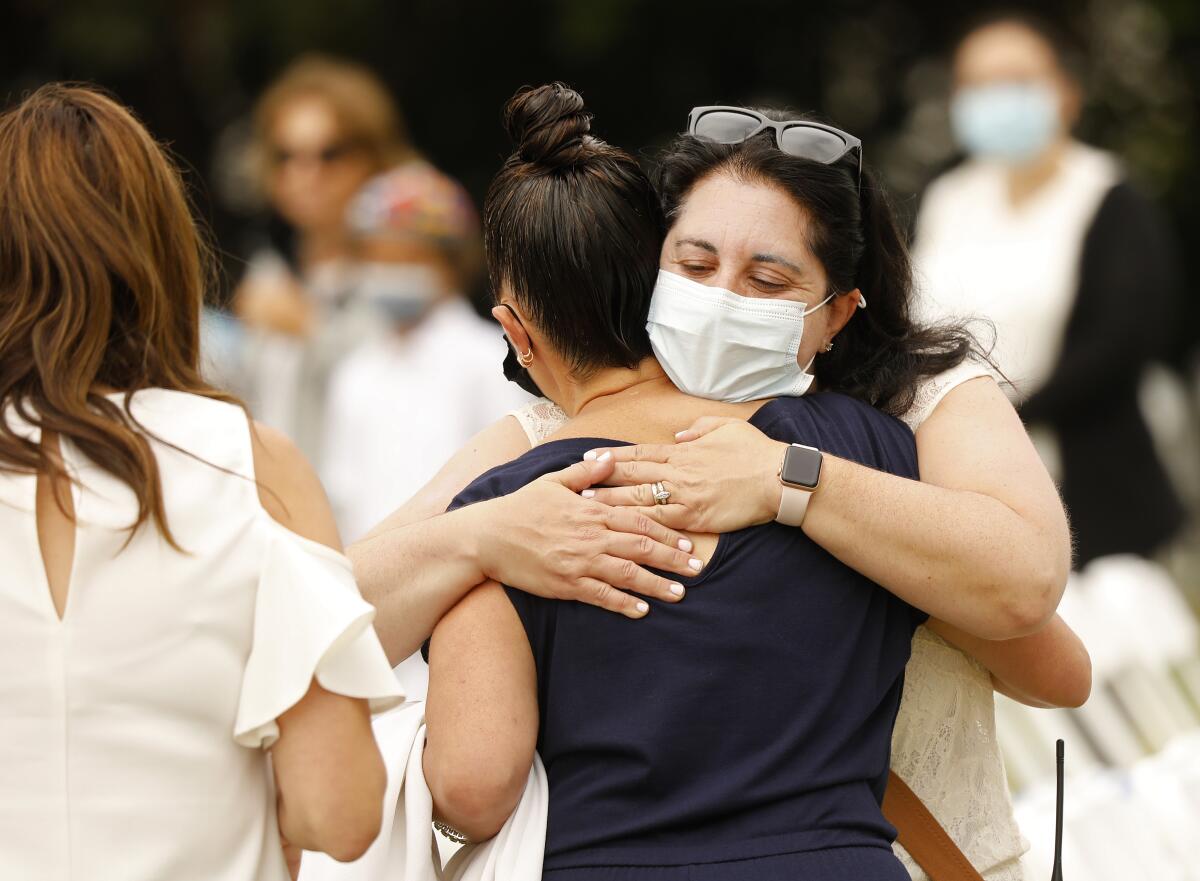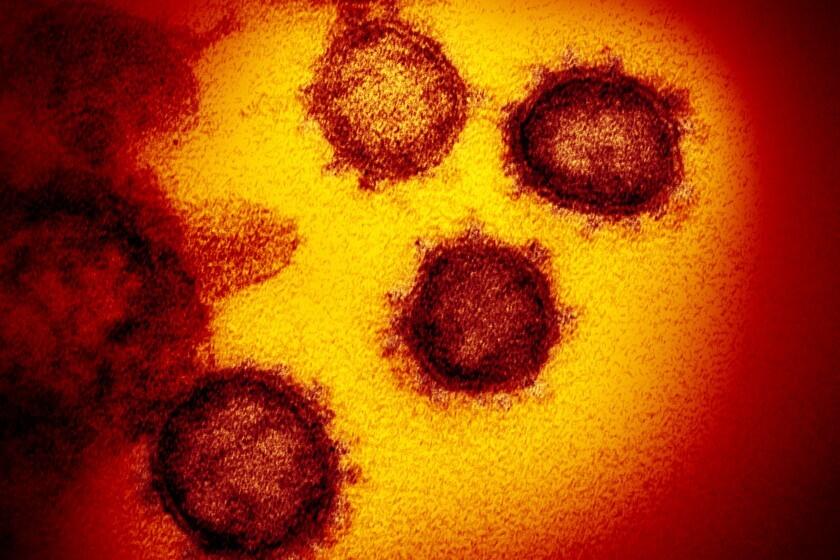California has the lowest coronavirus rate in the nation. Here’s what we know

- Share via
California officially has the lowest coronavirus case rate of any state, federal figures show, underscoring the progress made in the ongoing battle against the highly infectious Delta variant.
The state has been among the national leaders in that metric for the last week, as the number of newly confirmed coronavirus infections continues to tumble from a peak earlier this summer.
California’s new case rate per 100,000 people is less than half of neighboring states, according to data from the U.S. Centers for Disease Control and Prevention. Some hard-hit states have more than quadruple California’s numbers.
California’s coronavirus transmission level has fallen from ‘high’ to ‘substantial,’ the second-highest tier as defined by the CDC.
Statewide
As of Monday, California’s seven-day case rate was 95.3 per 100,000 people. The next-closest state was Connecticut, at 126.5.
The comparable rates over the same period were 385.1 cases per 100,000 people in Texas; 287.2 in Florida; 250.1 in Arizona; 234.7 in Oregon; and 202.5 in Nevada, federal data show.
The CDC categorizes states’ coronavirus transmission levels in one of four tiers: the worst — high — is color-coded as red, followed by substantial (orange), moderate (yellow) and low (blue).
With the latest update, California’s coronavirus transmission level has once again fallen to “substantial.” Every other state currently remains in the “high” transmission category.
The federal figures illustrate the recent success California has had in turning the tide of the Delta variant-fueled coronavirus wave.
Over the last week, the state has reported an average of 8,849 new cases per day — down about 33% from two weeks ago, according to data compiled by The Times.
COVID-19 hospitalizations, too, have plummeted lately. At the height of the current surge, more than 8,300 coronavirus-positive patients were hospitalized at one time statewide. Now, that daily census has fallen to just about 6,000, state data show.
But the progress has been uneven. While the Bay Area, in general, experienced the least-severe summer surge and Los Angeles has had success with new measures to slow the Delta variant, the Central Valley and parts of rural Northern California have been harder hit.
L.A. County will implement vaccine-or-testing requirements for large outdoor sporting events and theme parks as well as proof of vaccination at indoor bars, wineries, breweries and nightclubs.
L.A. County
Los Angeles County continues to report improvement in weekly COVID-19 cases and hospitalizations.
About a month ago, the county was averaging more than 3,400 new coronavirus infections a day over a one-week period, according to a Times analysis of state data. But over the last week, L.A. County averaged nearly 2,200 new cases a day.
And as of Sunday, 1,034 coronavirus-positive patients were hospitalized countywide — down roughly 42% from the month prior.
Nonetheless, coronavirus transmission levels remain at an elevated level.
“We can’t afford to be complacent with an average of 2,000 new cases and dozens of deaths each day,” county Public Health Director Barbara Ferrer said over the weekend. “In order to be better prepared for the fall and winter, typically seasons when many viruses thrive, we need to immediately reduce COVID transmission. Given the powerful tools at our disposal that we didn’t have last fall — rapid antigen tests and highly effective vaccinations — the high number of cases is troubling and reflects the unevenness of vaccination coverage and screenings.”
One Fresno area hospital had nine critically ill patients who weren’t able to get into the intensive care unit for more than three days.
Central Valley
But the situation remains grim elsewhere.
Hospitals throughout the San Joaquin Valley — which the state defines as Calaveras, Fresno, Kern, Kings, Madera, Mariposa, Merced, San Benito, San Joaquin, Stanislaus, Tulare and Tuolumne counties — have reported having less than 10% of their cumulative staffed adult ICU beds available for 19 straight days.
Some healthcare facilities in the region are still so overwhelmed with COVID-19 patients that some critically ill people are waiting days to be transferred into the intensive care unit from the emergency room, officials said.
One Fresno area hospital had nine critically ill patients who were unable to get into the intensive care unit for more than three days, interim health officer Dr. Rais Vohra said at a news conference last week. This forces emergency room staff to treat patients needing ICU care, disrupting the healthcare of other patients with less severe illness.
As the COVID-19 pandemic ravages California’s Central Valley, Fresno County is bracing for the possibility of having to ration healthcare in its hospitals, choosing who will receive lifesaving measures.
“We’re basically really straining what the emergency department has to do,” Vohra said. “We still anticipate at least a few more weeks of thoroughly impacted operations” in ICUs and emergency rooms.
Hospitals in Fresno County are teetering on the need to ration healthcare and implement “crisis standards of care,” Vohra said. In these situations, hospitals conclude that they no longer can provide the same standard of healthcare to everyone and must choose whose lives to prioritize to keep as many patients alive as possible.
In Fresno County and the greater San Joaquin Valley, hospitals remain extremely busy, said Dan Lynch, director of the Central California Emergency Medical Services Agency. Most of Fresno County’s hospitals are running at 108% to 110% of standard capacity, while Clovis Community Medical Center near Fresno has been running at 130% of capacity.
Vaccines
Officials say unvaccinated Californians continue to be infected at higher rates than their vaccinated counterparts.
During the week of Aug. 29 through Sept. 4, the average case rate among unvaccinated individuals was roughly eight times higher than for those who had been inoculated, according to the California Department of Public Health.
In the five states with the lowest levels of vaccination, the COVID-19 death rate this summer was more than triple the rate in the five states where vaccination is most common.
“The vaccines continue to be our best tool to put an end to this deadly pandemic,” Dr. Tomás Aragón, the department’s director and state public health officer, said in a statement last week.
Almost 66% of Californians have received at least one dose of COVID-19 vaccine. But the rates vary widely by community.
Eleven of the state’s 58 counties have seen more than 70% of their residents receive at least one shot to date, according to data compiled by The Times. However, 14 others have yet to partially inoculate even half of their population.
Unvaccinated people are also at far greater risk of being hospitalized. Of the hundreds admitted to L.A. County’s public hospital system since June 15 for a diagnosis primarily linked to COVID-19, 93% have been unvaccinated.
Most of the vaccinated people who have been hospitalized have compromised immune systems, and thus “are not able to mount a sufficient immune response after vaccination,” according to county Health Services Director Dr. Christina Ghaly.
More to Read
Sign up for Essential California
The most important California stories and recommendations in your inbox every morning.
You may occasionally receive promotional content from the Los Angeles Times.
















